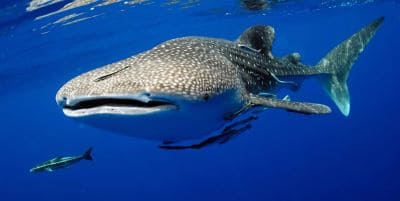Home › Scuba Diving Destinations › Asia › Thailand › Phi Phi › Red Rock
Scuba Diving at Hin Daeng (Red Rock)
One of Thailand's most legendary dive destinations is situated around ninety (90) kilometres south of Phuket, and even closer to the famous Phi Phi Islands.
This dive guide contains all the important information needed for divers who will be scuba diving at the Hin Daeng 'Red Rock' pinnacle near Koh Lanta.
What is the Best Season to Dive in Phi Phi?
Koh Phi Phi is an archipelago of six islands in Krabi Province, southern Thailand. The top locations for scuba diving and snorkeling are:
- Koh Phi Phi Don (Thai: พีพีดอน)
- Koh Phi Phi Leh (Thai: พีพีเล)
- Koh Mai Phai (Bamboo Island)
- Koh Yung (Mosquito Island)
- Koh Bida Nok (Thai: เกาะบิดานอก)
- Koh Bida Nai (Thai: เกาะบิดาใน)
They are all first-rate destinations for divers. But, Phi Phi Don is the only inhabited island in the group, and it has a total land mass of twelve (12) square kilometres.
A combination of stunning scenery, pristine white sand beaches, and cobalt blue water has transformed Koh Phi Phi Islands into one of the top landing places for Thailand diving destinations.
Here's the thing:
Koh Phi Phi dive sites get around three hundred days of sunshine per year and the water temperature rarely drops below 29° Celsius (84° Fahrenheit).
As a consequence of that, it's fair to say diving in Phi Phi is an annual activity. But, divers need to be mindful that the southwest monsoons usually arrive towards the end of May and continue through to the end of October.
At certain times of the year, the Andaman Sea can produce thirty (30) metres of underwater visibility. So, the best months for divers to enjoy clear water dives are January, February, and March.
Pro Tip: Check out our sea life section for interesting facts about whale sharks and manta rays that often make an appearance around the islands during the plankton-rich months between June and October.
Marine Life at Hin Daeng Thailand
The underwater topography at Hin Daeng (translated to Red Rock) is very similar to its twin, Hin Muang (translated to Purple Rock).
Both pinnacles are located in the Andaman Sea, roughly sixty (60) kilometres (33 nautical miles) southwest of Koh Lanta and about eighty (80) kilometres (44 nautical miles) south of the Phi Phi Islands.
For this reason, it is common for divers to join day trips or scuba liveaboards from Koh Lanta, Phi Phi, or Phuket to reach the Hin Daeng and Hin Muang dives sites.
Apart from the large ocean-going pelagics, the vibrant reef environment is the ideal setting for sea fans, crinoids, and masses of red and purple soft corals. You should also get to see:
- Barracudas (Sphyraenidae)
 Blacktip reef sharks (Carcharhinus melanopterus)
Blacktip reef sharks (Carcharhinus melanopterus)- Giant carpet anemone (Stichodactyla gigantea)
- Lionfish (Scorpaenidae)
- Manta Rays (Myliobatiformes)
- Moray eels (Muraenidae)
- Nudibranchs (sea slugs)
- Rainbow runner (Elagatis bipinnulata)
- Schooling fusilier fish (Caesionidae)
- Scorpionfish (Scorpaenidae)
- Whale sharks (Rhincodontidae)
Some of the southern islands have become key breeding grounds for large marine reptiles (e.g. turtles). In fact, there are regular events to reintroduce juvenile turtles back into the vibrant ecosystems and help stimulate the growth of colourful coral reefs.
Tips for Divers at The Red Rock
Some experienced divers consider the two 'sister sites' of Hin Daeng and Hin Muang among the best diving spots in the world - and definitely worth a trip for Thailand divers!
They are dramatic marine sites, and maybe second only to the world famous Similan Islands for Thai divers who want forty-metre visibility and regular sightings of big fish.
Let's dive in:
The underwater rock formation creates a stunning submerged reef in the open sea that attracts large pelagic fish, especially manta rays and whale sharks.
But, it's worth noting that the biggest fish and whale sharks are mostly spotted during the plankton bloom months, generally from February to the end of April.
Maximum Depth and Topography
Hin Daeng is a submerged pinnacle that rises up from a depth of sixty (60) metres to meet the waves at sea level.
The name (red rock) comes from the superabundance of red soft coral formations that cover the walls of a number of vertical drop-offs and crevices.
The twin site of Hin Muang "Purple Rock" is only a few hundred metres away. But, this particular diving location is covered with purple soft coral formations and it's a little bit deeper.
Key points...
Both underwater sites are exposed and there is very little shelter from choppy waves, strong water currents, and inclement weather conditions.
Nonetheless, the diving depths range from 5 to 60 metres at the seabed. The visibility rarely drops below twenty (20) metres (65 feet) and you can get up to forty (40) metres (130 feet) at optimum times of the year.
Dive Planning and Safety Tips
Scuba divers need a minimum scuba certification of Advanced Open Water (or one of the accepted PADI equivalent qualifications).
Most of the local dive schools also recommend having Deep Diver Specialty and Drift Diver Specialty qualifications.
Some of the other industry standard safety diving equipment also includes carrying a Surface Marker Buoy (SMB), wearing a dive computer, and using a reef hook.
Important: In the interest of safety, scuba emergency response procedures need to be addressed! At Hin Daeng dive site, you will have short no-decompression limits (NDLs) and there will be almost no access to immediate surface shelter (excluding the dive boat). So it's important to be aware that the nearest recompression chamber will be in Koh Lanta or Phuket.